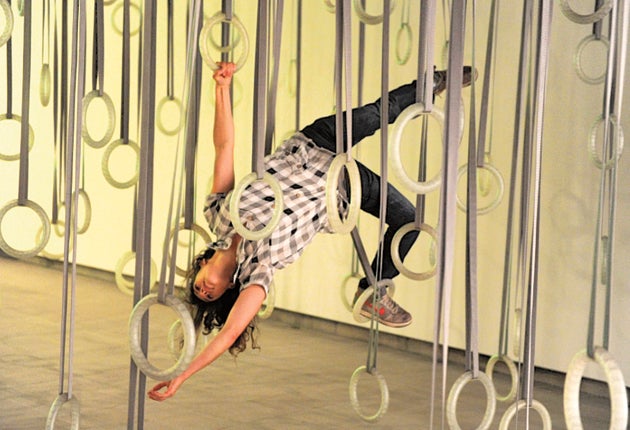Move: Choreographing You, Hayward Gallery, London

Your support helps us to tell the story
From reproductive rights to climate change to Big Tech, The Independent is on the ground when the story is developing. Whether it's investigating the financials of Elon Musk's pro-Trump PAC or producing our latest documentary, 'The A Word', which shines a light on the American women fighting for reproductive rights, we know how important it is to parse out the facts from the messaging.
At such a critical moment in US history, we need reporters on the ground. Your donation allows us to keep sending journalists to speak to both sides of the story.
The Independent is trusted by Americans across the entire political spectrum. And unlike many other quality news outlets, we choose not to lock Americans out of our reporting and analysis with paywalls. We believe quality journalism should be available to everyone, paid for by those who can afford it.
Your support makes all the difference.Wear comfortable clothes and flat shoes to visit Move: Choreographing You at the Hayward, because to experience this exhibition properly, you will be swinging, crawling and balancing your way through the galleries. This vast show takes into account dance and contemporary art since the 1960s, and it's based on the premise that you, the visitor, are the dancer, and that the objects in the space manipulate your movement somehow. So you will find yourself squeezing sideways down Bruce Nauman's very narrow Green Light Corridor, feeling trapped and anxious, or stumbling in the dark through Lygia Clark's The House Is the Body. Penetration, ovulation, germination, expulsion, which creates a kind of brilliantly barmy sense of inhabiting a woman's body and then being born out of a woolly chamber. You can swing across the gallery (no easy task) on a series of gym rings by William Forsythe and goose-step over buckets of water in Trisha Brown's Stream on the outdoor sculpture terrace. A couple of Robert Morris's brilliant Bodyspacemotionthings, sculptures for balancing on, are here, subversive in the sense that they always feel rather dangerous.
The Hayward has made itself a home for such exhibitions of interactivity and playfulness, though this exhibition has serious art historical undertones. Contemporary dance has had an immense (but often unseen) influence on contemporary art, particularly on performance art and sculpture. This is a timely attempt to put choreography back at the heart of the story of art, and the exhibition has moments of great works in it: Robert Morris, Tania Bruguera, Bruce Nauman, and the sculptural installations by Mike Kelley, Simone Forti and Pablo Bronstein that are "activated" by dancers from Trinity Laban.
However in the end, one has to say that these works get rather swamped by the fact that there is really too much in the show, and the message gets rather confused. When a particular thematic strand begins to settle its signal is jammed by the sheer amount of eclectic work here. It would have been better to see less works in a more concise fashion, and there are several pieces that really belong in another show. The pieces involving the dancers feel radically different to those involving the viewer's participation, for example, as though they, strangely, almost don't belong together. Isaac Julien's new epic video installation TEN THOUSAND WAVES, which takes the deaths of the Chinese cockle pickers at Morecambe Bay is radically out of place, as are some more archival presentations and 3D video installations. The huge digital archives that one is encouraged to look through seem to reveal, not only the breadth of the subject, but the need for a stricter editor. Though there is so much to be explored in this area, in the fertile ground between performance and sculpture, in work that can be radical and political and, yes, moving, I'm afraid it's very clear that it can't be done all at once.
To 9 January (0844 875 0073)
Join our commenting forum
Join thought-provoking conversations, follow other Independent readers and see their replies
Comments